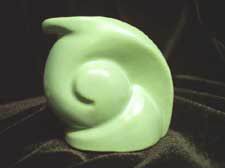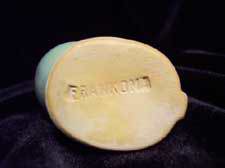How to Identify Frankoma Clay
 Ada Clay
Ada Clay
 Ada Clay - Reverse
Ada Clay - Reverse
One of the many interesting things about collecting Frankoma pottery is to learn about, and identify the pieces according to what clay was used. John Frank worked with clay from different locales in Oklahoma. He settled on a deposit of tan firing clay from the Arbuckle Mountains, several miles out of Ada, Oklahoma.
Frankoma used this clay from 1933 until 1954. Collectors refer to it as Ada Clay. Frank discovered this deposit while teaching at the University of Oklahoma, which he used for his art classes. This clay had to be extracted from the ground similar to digging trenches. Over the years the quality of this clay declined past an acceptable level. Tree branches and other trash built up, which had to be cleared before more clay was extracted. Then, the clay had to be hauled 150 miles by truck to Sapulpa.
Switching to Sapulpa Clay
In late 1954, the company switched to a brick red firing clay whih was several miles from the factory in Sapulpa, Oklahoma. This clay was extracted from Sugar Loaf Hill and is referred to as Sapulpa clay. A local brick manufacturer used this deposit for making bricks. This mineral rich clay significantly changed the appearance of many of the glazes, especially the rutile ones (Prairie Green, Woodland Moss, Peach Glow, Desert Gold, Brown Satin).
Further, during the 1980's, the clay was infused with additives which affected the color. This changed it from red to a light pink or a light orange.
Differences in Clays
Many people use the "wet finger method" to determine whether a piece is made of Ada Clay or Sapulpa Clay. The method is this: Wet the end of your finger and touch the unglazed portion (usually the bottom) of the item in question. The theory is that, if it is Ada clay, it will not change color. If it is Sapulpa clay, it will visibly darken. This method is generally, but not 100 percent, accurate.
The experienced Frankoma collector will take several things into consideration in determining a piece's provenance. They are backstamp, clay color and glaze.
More questions? Ask and participate on our Frankoma Message Board. Registration is free.
